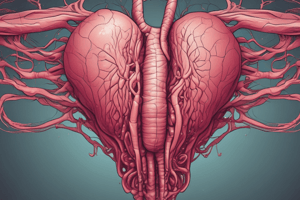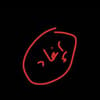Podcast
Questions and Answers
What are the two primary components of the placenta by the beginning of the fourth month?
What are the two primary components of the placenta by the beginning of the fourth month?
- Decidua basalis and yolk sac
- Chorionic plate and decidual plate
- Chorion frondosum and decidua basalis (correct)
- Chorion frondosum and decidua capsularis
During the formation of the placenta, what purpose do the decidual septa serve?
During the formation of the placenta, what purpose do the decidual septa serve?
- They aid in the transport of nutrients from the mother to the fetus.
- They fully compartmentalize the placenta into independent structures.
- They provide a syncytial layer separating maternal blood from fetal tissue. (correct)
- They connect different cotyledons to share maternal blood supply.
What is the average weight of a full-term placenta?
What is the average weight of a full-term placenta?
- 700 to 800 g
- 300 to 400 g
- 500 to 600 g (correct)
- 900 to 1000 g
What characteristic distinguishes the fetal surface of the placenta at full term?
What characteristic distinguishes the fetal surface of the placenta at full term?
What happens to the placenta shortly after the birth of the child?
What happens to the placenta shortly after the birth of the child?
Which statement accurately describes the maternal circulation within the placental circulation system?
Which statement accurately describes the maternal circulation within the placental circulation system?
What is a key function of the placenta regarding maternal and fetal exchanges?
What is a key function of the placenta regarding maternal and fetal exchanges?
Which is not a layer of the placental barrier during early pregnancy?
Which is not a layer of the placental barrier during early pregnancy?
How does the structure of the placental membrane change by the fourth month of pregnancy?
How does the structure of the placental membrane change by the fourth month of pregnancy?
What materials does the placenta specifically allow to pass between maternal and fetal blood?
What materials does the placenta specifically allow to pass between maternal and fetal blood?
Flashcards
Placental Circulation
Placental Circulation
The system that allows the exchange of nutrients, oxygen, and waste products between the mother and the fetus through the placenta.
Maternal Circulation (placenta)
Maternal Circulation (placenta)
The part of placental circulation within the mother's body that delivers oxygen and nutrients to the fetus and removes waste.
Placental Barrier (definition)
Placental Barrier (definition)
Structures separating fetal and maternal blood, allowing selective exchange of materials, preventing mixing.
Placental Barrier Layers
Placental Barrier Layers
Signup and view all the flashcards
Placental Function - Excretion
Placental Function - Excretion
Signup and view all the flashcards
Placenta origin
Placenta origin
Signup and view all the flashcards
Placental Structure (Full Term)
Placental Structure (Full Term)
Signup and view all the flashcards
Placental Barrier
Placental Barrier
Signup and view all the flashcards
Umbilical Cord Attachment
Umbilical Cord Attachment
Signup and view all the flashcards
Placenta Cotyledons
Placenta Cotyledons
Signup and view all the flashcards
Study Notes
Placenta and Umbilical Cord
-
Placenta Structure and Origin: By the 4th month, the placenta has two parts: a fetal portion (chorion frondosum) and a maternal portion (decidua basalis). The chorionic plate borders the fetal side, and the decidual plate borders the maternal side. The intervillous spaces between these plates are filled with maternal blood.
-
Placenta Development: Decidual septa form within the intervillous spaces, but do not reach the chorionic plate. These septa create compartments called cotyledons, which maintain contact between intervillous spaces in various sections. This structure keeps maternal and fetal blood separate, but allows for nutrient and gas exchange.
-
Placental Circulation: Maternal blood enters the intervillous spaces through spiral arteries, and fetal blood enters through the umbilical vein. Oxygen and nutrients pass from maternal to fetal blood, while carbon dioxide and waste pass from fetal to maternal blood through the placental barrier.
-
Placental Functions: The placenta performs several key functions: nutrition, excretion, respiration, and protection (prevents toxins, drugs, and microorganisms from passing from mother to fetus).
Umbilical Cord
-
Full-Term Cord Structure: At birth, a typical umbilical cord is approximately 50-60 cm long and 2 cm in diameter. It has a tortuous structure, sometimes containing false knots. It typically contains two arteries and one vein surrounded by Wharton's jelly.
-
Umbilical Cord Development: The umbilical cord initially develops as a primitive structure including: body stalk containing allantois and umbilical blood vessels; yolk stalk and vitelline blood vessels; and the remaining part of extra embryonic coelom. As development progresses, the extra embryonic coelom and allantois obliterate, and the yolk stalk degenerates, leaving the definitive umbilical cord with umbilical blood vessels and Wharton's jelly covered by amniotic membrane.
Placental and Umbilical Cord Abnormalities
- Placental Anomalies: Bilobed or trilobed placentas, accessory placentas, and placenta previa (centralis, marginalis, or parietalis) are potential abnormal conditions. A long umbilical cord can sometimes cause difficulties in delivery, while a short cord may present challenges due to limited flexibility. Other potential anomalies include one umbilical artery (increased risk of cardiac defects), velamentous insertion, and exomphalos.
Studying That Suits You
Use AI to generate personalized quizzes and flashcards to suit your learning preferences.





